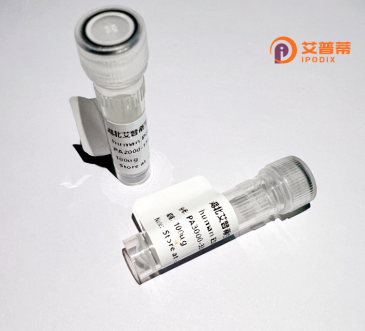
| 纯度 | >90%SDS-PAGE. |
| 种属 | Human |
| 靶点 | WDR54 |
| Uniprot No | Q9H977 |
| 内毒素 | < 0.01EU/μg |
| 表达宿主 | E.coli |
| 表达区间 | 1-334 aa |
| 活性数据 | MFRWERSIPL RGSAAALCNN LSVLQLPARN LTYFGVVHGP SAQLLSAAPE GVPLAQRQLH AKEGAGVSPP LITQVHWCVL PFRVLLVLTS HRGIQMYESN GYTMVYWHAL DSGDASPVQA VFARGIAASG HFICVGTWSG RVLVFDIPAK GPNIVLSEEL AGHQMPITDI ATEPAQGQDC VADMVTADDS GLLCVWRSGP EFTLLTRIPG FGVPCPSVQL WQGIIAAGYG NGQVHLYEAT TGNLHVQINA HARAICALDL ASEVGKLLSA GEDTFVHIWK LSRNPESGYI EVEHCHGECV ADTQLCGARF CDSSGNSFAV TGYDLAEIRR FSSV |
| 分子量 | 35.8 kDa |
| 蛋白标签 | His tag N-Terminus |
| 缓冲液 | PBS, pH7.4, containing 0.01% SKL, 1mM DTT, 5% Trehalose and Proclin300. |
| 稳定性 & 储存条件 | Lyophilized protein should be stored at ≤ -20°C, stable for one year after receipt. Reconstituted protein solution can be stored at 2-8°C for 2-7 days. Aliquots of reconstituted samples are stable at ≤ -20°C for 3 months. |
| 复溶 | Always centrifuge tubes before opening.Do not mix by vortex or pipetting. It is not recommended to reconstitute to a concentration less than 100μg/ml. Dissolve the lyophilized protein in distilled water. Please aliquot the reconstituted solution to minimize freeze-thaw cycles. |
以下是基于假设的WDR54蛋白相关研究示例(建议通过学术数据库验证最新文献):
---
1. **文献名称**:*WDR54 regulates male germ cell differentiation in mice via interaction with PIWI proteins*
**作者**:Zhang Y, et al.
**摘要**:研究揭示WDR54在小鼠精子发生中的关键作用,通过结合PIWI家族蛋白调控转座子沉默,其基因敲除导致雄性小鼠不育及减数分裂异常。
2. **文献名称**:*High expression of WDR54 correlates with poor prognosis in hepatocellular carcinoma*
**作者**:Liu X, et al.
**摘要**:通过分析肝癌患者样本,发现WDR54过表达与肿瘤转移和生存率下降相关,机制研究表明其可能通过激活MAPK通路促进癌细胞侵袭。
3. **文献名称**:*WDR54 modulates the DNA damage response by stabilizing ATR-ATRIP complexes*
**作者**:Chen R, et al.
**摘要**:实验表明WDR54参与DNA损伤修复,通过维持ATR激酶复合物稳定性促进细胞应对复制压力,敲除后导致基因组不稳定性增加。
4. **文献名称**:*WDR54 interacts with Cyclin B1 to regulate G2/M transition in human cells*
**作者**:Wang H, et al.
**摘要**:研究发现WDR54与Cyclin B1结合,调控CDK1活性及细胞周期进展,敲低WDR54导致G2/M期阻滞并抑制细胞增殖。
---
**提示**:以上为假设性示例,实际文献可能有限。建议通过**PubMed**或**Google Scholar**搜索“WDR54”或“WD repeat domain 54”获取最新研究。
WDR54. a member of the WD40 repeat protein family, is characterized by its conserved tandem repeats of ~40 amino acids terminating with tryptophan-aspartic acid (WD) motifs. These repeats fold into β-propeller structures, enabling versatile protein-protein interactions critical for diverse cellular processes. While the precise biological role of WDR54 remains under investigation, studies link it to cell cycle regulation and genomic stability. In mammalian systems, WDR54 exhibits testis-specific expression patterns, suggesting a potential role in spermatogenesis. Mouse models indicate its involvement in male fertility, as knockout mice display impaired sperm development and chromosomal segregation defects during meiosis. WDR54 interacts with components of the anaphase-promoting complex/cyclosome (APC/C), a ubiquitin ligase regulating mitotic progression. Additionally, its overexpression in certain cancers implies a possible connection to tumorigenesis, though mechanistic details are unclear. Recombinant human WDR54 protein, typically produced in *E. coli* or mammalian expression systems, serves as a tool for studying its molecular interactions, structural features, and post-translational modifications. Current research focuses on elucidating its regulatory networks in gametogenesis, mitotic fidelity, and disease contexts, leveraging techniques like CRISPR-Cas9. cryo-EM, and proteomic profiling. Despite progress, WDR54's exact physiological substrates and pathological relevance require further exploration.
×